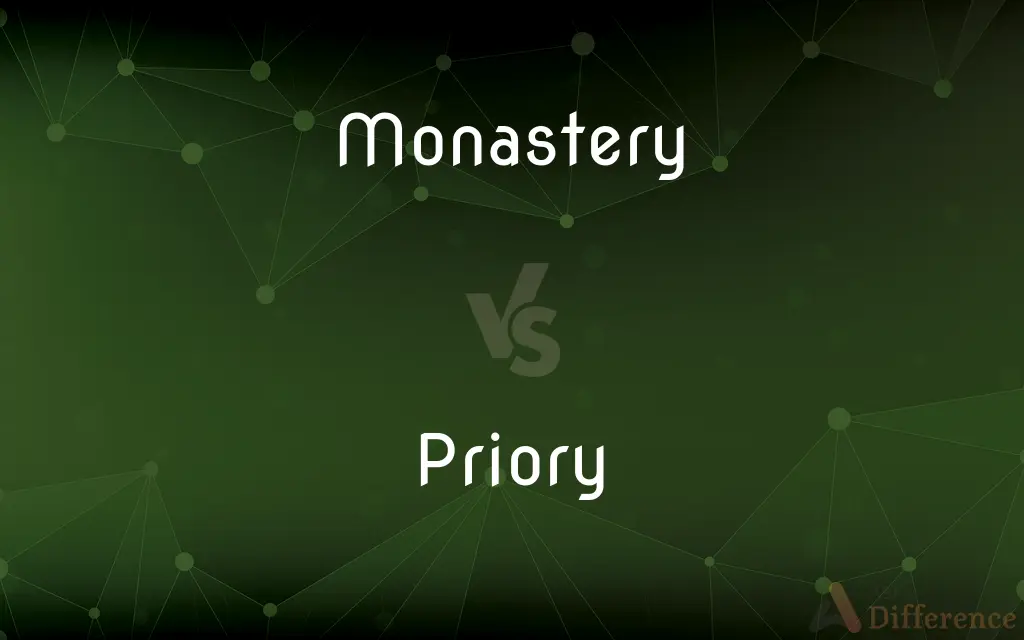Monastery vs. Priory — What's the Difference?
Edited by Tayyaba Rehman — By Urooj Arif — Updated on April 21, 2024
A monastery is a residence or complex of buildings where monks or nuns live, work, and worship, typically secluded from the secular world. A priory is similar but usually smaller and governed by a prior or prioress, subordinate to a larger monastery.

Difference Between Monastery and Priory
Table of Contents
ADVERTISEMENT
Key Differences
Monasteries are religious communities where monks or nuns live under vows of poverty, chastity, and obedience. They are often self-contained, with their own churches, living quarters, and sometimes gardens or agricultural land. In contrast, a priory is typically smaller and may function as a subsidiary to a larger monastery. It is led by a prior or prioress and may house fewer members of the religious order.
In terms of governance, monasteries are usually autonomous and may be the center of a network of smaller religious houses. A priory, while it can be independent, is often part of a larger ecclesiastical hierarchy, reporting to a monastery. This hierarchical relationship is a key distinguishing feature between the two.
Monasteries are usually more expansive, built to accommodate a larger community and more diverse activities, including hosting important religious ceremonies. Priors, though they might share architectural styles with monasteries, are generally smaller with facilities scaled to their community size.
The roles and functions of monasteries extend beyond the religious, often involving significant contributions to the local community through education, hospitality, and medical care. Whereas priories, due to their smaller size and resources, usually focus more on the spiritual life and may have less engagement with external activities.
The distinction between monastery and priory has also reflected their origins and the orders to which they belong. For example, Benedictine monks typically inhabit monasteries, while smaller priories might belong to newer or less widespread orders.
ADVERTISEMENT
Comparison Chart
Definition
A community and residence for monks or nuns.
A smaller religious house led by a prior or prioress.
Size
Larger, often with extensive facilities.
Smaller, with more limited facilities.
Governance
Autonomous or a hub in a religious network.
Often subordinate to a monastery.
Functions
Religious worship, community services, education.
Primarily religious worship, some community roles.
Architectural Scale
Expansive, complex structures.
Typically smaller, simpler structures.
Compare with Definitions
Monastery
A place where communities of monks or nuns live, work, and worship.
The monastery atop the hill has been a place of pilgrimage for centuries.
Priory
Often part of a larger ecclesiastical structure.
As a dependency of the grand monastery, the priory follows its directives.
Monastery
Typically independent and may be the mother house to other religious sites.
The monastery in the city is the oldest and serves as the headquarter for the order.
Priory
Led by a prior or prioress and home to a smaller community.
The priory is home to a dozen nuns and is led by a respected prioress.
Monastery
Often large and self-sufficient, sometimes isolated.
The ancient monastery features its own gardens and water supply.
Priory
Simpler in scale and function compared to a monastery.
The priory consists of a small chapel and living quarters for its members.
Monastery
Central in religious practices and may serve broader community roles.
The local monastery runs a school and a medical clinic.
Priory
A smaller religious house, often under the governance of a larger monastery.
The nearby priory is governed by the larger monastery across the river.
Monastery
Architecturally significant, often historic.
The monastery’s architecture reflects its Byzantine influences.
Priory
Focuses on religious life, sometimes with limited external engagements.
The priory maintains a quiet presence, focusing on prayer and contemplation.
Monastery
A monastery is a building or complex of buildings comprising the domestic quarters and workplaces of monastics, monks or nuns, whether living in communities or alone (hermits). A monastery generally includes a place reserved for prayer which may be a chapel, church, or temple, and may also serve as an oratory, or in the case of communities anything from a single building housing only one senior and two or three junior monks or nuns, to vast complexes and estates housing tens or hundreds.
Priory
A priory is a monastery of men or women under religious vows that is headed by a prior or prioress. Priories may be houses of mendicant friars or nuns (such as the Dominicans, Augustinians, Franciscans, and Carmelites), or monasteries of monks or nuns (as with the Benedictines).
Monastery
A community of persons, especially monks, bound by vows to a religious life and often living in partial or complete seclusion.
Priory
A monastery governed by a prior or a convent governed by a prioress.
Monastery
The dwelling place of such a community.
Priory
A monastery or convent governed by a prior or prioress.
Monastery
A residence for monks or others who have taken religious vows.
Priory
A religious house presided over by a prior or prioress; - sometimes an offshoot of, an subordinate to, an abbey, and called also cell, and obedience. See Cell, 2.
Monastery
A house of religious retirement, or of secusion from ordinary temporal concerns, especially for monks; - more rarely applied to such a house for females.
Priory
Religious residence in a monastery governed by a prior or a convent governed by a prioress
Monastery
The residence of a religious community
Common Curiosities
What is a monastery?
A monastery is a residence for monks or nuns where they live, work, and worship, often secluded from the secular world.
Are priories always smaller than monasteries?
Typically, yes, priories are smaller and have fewer resources compared to monasteries.
How does a priory differ from a monastery?
A priory is generally smaller and often subordinate to a monastery, led by a prior or prioress.
Can a priory operate independently of a monastery?
While some priories are independent, they are typically part of a larger religious organization and may be subordinate to a monastery.
Do all monks and nuns live in monasteries?
While many do, some live in priories, hermitages, or other religious communities.
What roles do monasteries play in their communities?
Monasteries often provide education, hospitality, and medical care to local communities, alongside their religious functions.
Can a priory become a monastery?
Yes, if a priory grows in size and significance, it can be elevated to the status of a monastery.
Why might a religious order choose to establish a priory instead of a monastery?
Establishing a priory can be due to strategic religious expansion, resource management, or the needs of a smaller community of religious members.
What architectural differences exist between monasteries and priories?
Monasteries are usually more extensive and complex, while priories are simpler and smaller in scale.
What is the main focus of a priory’s activities?
The main focus is on spiritual life and religious observance, with less emphasis on external community services.
Can women lead a priory?
Yes, women can lead a priory if they hold the position of prioress.
How does the community size differ between a monastery and a priory?
Monasteries typically house larger communities, whereas priories are home to smaller groups of religious individuals.
How does the governance structure impact a priory?
Being part of a larger religious hierarchy, priories often adhere to directives from their supervising monastery.
What historical significance do monasteries have?
Many monasteries are historic, serving as centers of religious, cultural, and scholarly activities for centuries.
What are the educational roles of monasteries?
Many monasteries run schools, colleges, and educational programs for the local community and their members.
Share Your Discovery

Previous Comparison
Battle vs. War
Next Comparison
Wary vs. WorryAuthor Spotlight
Written by
Urooj ArifUrooj is a skilled content writer at Ask Difference, known for her exceptional ability to simplify complex topics into engaging and informative content. With a passion for research and a flair for clear, concise writing, she consistently delivers articles that resonate with our diverse audience.
Edited by
Tayyaba RehmanTayyaba Rehman is a distinguished writer, currently serving as a primary contributor to askdifference.com. As a researcher in semantics and etymology, Tayyaba's passion for the complexity of languages and their distinctions has found a perfect home on the platform. Tayyaba delves into the intricacies of language, distinguishing between commonly confused words and phrases, thereby providing clarity for readers worldwide.














































